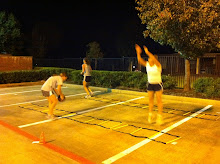
Forget about counting calories, cutting carbs or tracking points. To shrink your waistline, start by shrinking your portions.
"If you want to lose weight, you've got to eat less calories. It's very simple math, but people don't want to see it," says Lisa Young, a registered dietitian and author of The Portion Teller Plan.
"I don't care if the food has omega-3 in it, I don't care if it has vitamin D in it, I don't care if it has calcium in it. You've got to eat less of it."
Portion sizes have been growing exponentially in this country for decades, and we've grown with them.
According to the U.S. Department of Agriculture, the average hamburger in 1957 was just 1 ounce of cooked meat. By 1997, it was 6 ounces.
In that 40-year span, a "large" soda grew from 8 ounces to 32 ounces or more, and a medium box of popcorn at the movies swelled from 3 cups to 16 cups.
Between the early 1960s and 2005, the prevalence of obesity in U.S. adults increased from about 13 percent to about 35 percent, according to the Centers for Disease Control and Prevention.
"We go to restaurants, we get these very large portion sizes that are sometimes two or three times what we need," says Rayna Wooten, owner of Nutrition Therapy Associates in San Antonio. "That definitely distorts things and makes it more difficult translating things at home."
The next time you order fried chicken at a restaurant or dish spaghetti onto your plate at home, pause a moment and try to guess how many servings you're about to eat. If you're like many Americans, you'll underestimate nearly every time.
One reason we love big portions? We love value. We pride ourselves on getting a bargain — 64 ounces of soda for only $3 or a cheeseburger the size of a toddler's head for $5. Unfortunately, it's at the expense of our bodies.
If we ate and drank only what we were truly hungry and thirsty for, big bags of popcorn and jumbo burgers might not present such a problem.
But that's not how it works.
"We eat with our eyes, not with our stomachs," says Brian Wansink, author of Mindless Eating: Why We Eat More Than We Think.
Studies show that what we eat is influenced by everything from plate size (we eat more off bigger plates) to serving size (we eat more if we're given larger servings) to food visibility (we eat food when we see it, not always because we're hungry).
We also eat more when we don't see the whole amount we're consuming, such as when we dine or snack out of a package or a container.
If we were to see how much we were eating, we'd likely eat 15 percent or 20 percent less, Wansink says.
Often, we just don't know when to stop. In an experiment at the Cornell University Food and Brand Lab, Wansink found subjects consumed more tomato soup when a hidden tube kept filling their bowls as they ate.
The easiest way to eat less? Change our environment so it's harder to overeat, he says.
That means setting the table with smaller plates, using smaller serving spoons to dish out food and keeping candy dishes off our desk at work.
Deeper issues
Sometimes we overeat because we're hungry for something besides food.
People often eat past the point of fullness when they are using food as a distraction from problems - a way to cope with boredom, stress, grief or anxiety - or as a reward, says Samantha Rushing, a licensed professional counselor with Southwest Psychotherapy Associates in Houston.
Unresolved emotional trauma also can cause people to turn to food as a way to cope, says Rushing, who works with surgical and nonsurgical weight-loss patients. They use food to numb feelings of shame, guilt, inadequacy and powerlessness; as with any addiction or compulsion, food is a drug that offers escape.
People struggling with weight-loss issues may benefit from therapy to treat emotional eating.
"I say, 'The golden rule for eating is to treat yourself the way you want to feel,'" Rushing says. "People really pause with that because most of them have never felt their feelings. This is an invitation for the first time in their lives to sit with those feelings and understand that the feeling won't kill them."




















No comments:
Post a Comment